#integrativepractise
Explore tagged Tumblr posts
Text
Week 4:
Material Interrogation:

This was my selected object. It’s a st Christopher necklace which I got before I went travelling on my OE, it’s meant to keep you safe travelling and I met many other people around the world also with one so it was a good conversation starter and way to make friends.
At first I took that initial photo, then put it into a text editor where the data of the photo comes up.

After deleting parts, adding parts, moving bits around for a while, I saved the data and saw what happened to the image.

Then I added the image as raw data to audacity. As it was pretty much just white noise I played around with the sound first. Sapling wasn’t working so I only got the one sound edited through audacity.
I really liked this method as it got me thinking creatively and outside of the box. Showed us how something so simple can be manipulated and transformed into something completely new. What Clint was saying about using things in the incorrect/ unintended way was an interesting way to look at how we use apps and programs. The creative opportunities are endless when we start thinking in new ways.
2 notes
·
View notes
Text
SOUNDSCAPE / SOUNDWALK
Khartoum Place:
a generator humming in the back of a restaurant kitchen. Muffled voices at surrounding cafes and people on their lunch breaks. Construction crashing, clattering, banging. Faint traffic noises from nearby main road.
I think this place could sound a lot better if the broken water feature was repurposed. It hasn’t worked in years but it is connected to a a memorial of women’s suffrage in NZ. Different sounds could be played so you hear them change as you walk up the flights of stairs surrounding the fountain.
I think this would change peoples experience in this place, as it is bringing life back to a pretty empty corner of the city where there used to be such a grand feature. It would become more of a ‘destination’ rather than just a shortcut into high st.

Queen St Cinema :
Stairwell: faint beeping and clicking from arcade games. A phone ringing. The rushing of traffic from outside, movie trailers playing in the background, the rustling or food wrappers.
the stairwell is unique as it is spiral and is like walking down a cylinder, speakers going around with the shape of the stairwell could make it a more interesting experience.
I think this would add to peoples experience of going to the movies, it is a cool building as it is, but adding just a touch more before seeing a film could make it really fun.
Top floor: squeaking of escalators and the high pitch squealing of the lift. Rattling or ceiling fans, rumbling of movies playing inside.
the top floor of this building feels very isolated and when you look over the edge, you see just how high up you are, I think sounds that could add to that feeling of being up in the quiet, close to the ceiling could also add to the experience. Maybe speakers in the ceiling, this would also help block out any unwanted and unpleasant noises such as the lift, escalators and ceiling fans.

Myers Park:
Construction, loud crashing, banging, cluttering, rumbling, drilling. Faint bird song up in the trees. A siren from the road nearby. Grass rustling from footsteps
Myers park is a lovely place however the constant sounds of traffic and construction really take away the feeling of stepping out of the city that this park could achieve. I think a panel of speakers following the path people walk could play sounds that are calm and peaceful and drown out the city noises. This would make it a much more enjoyable experience.

1 note
·
View note
Text



These are our groups drawings of patterns all placed on the table.
At first we organised them with the most congested(full) pages in the centre and had more and more blank space as it spread out. This didn’t look too good so we tore apart each little drawing and made a collage with the darkest lined patterns in the centre and the lighter lined patterns as it spread out from the middle
1 note
·
View note
Text
Week 11
future uni
Our group made a strategy for a future university in 2050. As the educational system around the world is now more online than ever and covid is still a big issue, it is possible that an entirely online university is the future. This would have to be altered to cater for courses that are practical and skill based rather than theory based (which are easier to carry out online). AI or another type of technology would have to be used for students to carry out their practical assignments and work.
Through systems thinking we saw a potential connection between students who do practical based courses and lack of motivation. Since they can’t do their work as planned, it’s not at the intended level of work they want and it’s almost impossible i todays physical limits.
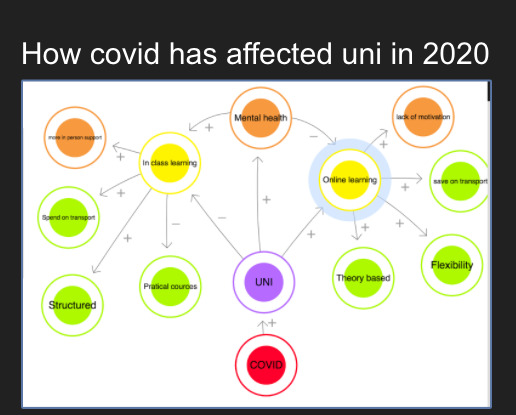
We discussed that a cultural probe in a current open university would help give us real answers to tell us if our system we designed is correct/on the right idea. Potentially a happy or sad button in an elevator with a question saying practical or theory,(so we know what course type they are doing) and then options for lost motivation, gained motivation and not affected (so we can see how their motivation was affected in lockdown).

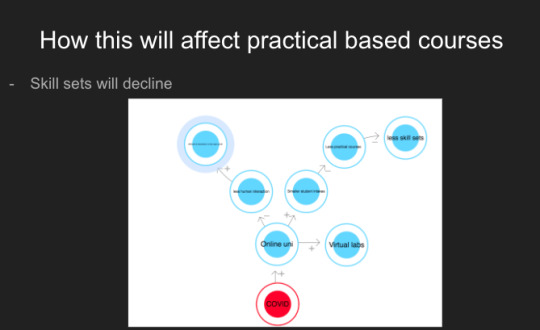
0 notes
Text
week 10
system thinking
In class this week we looked at systems and system thinking, how everything interconnects and how one thing can affect something drastically different through a series of connections. We were given opportunities to try out and make systems ourselves using Loopy.
Our first task was to connect rabbits and wolves and see how their connections to each other and then to more aspects of life would look. We could then visually see how each ‘party’ is affected. For this first one we were still understanding Loopy so it isn’t as detailed as it could have been but still shows our thinking process.

Our second task was working with ‘Wicked Problems’, a much bigger issue. Our task was to see how damp homes can lead to deprivation. We were then asked to make a hypothetical solution with our agency to the problem. We managed to get a lot of points in our Loopy and we were happy with our solution. We decided that we would campaign for state homes to be made from good standard materials so that there would be less damp homes. By pitching this as a policy for political parties to use it would raise their voting numbers with the young people who feel passionate about this issue.
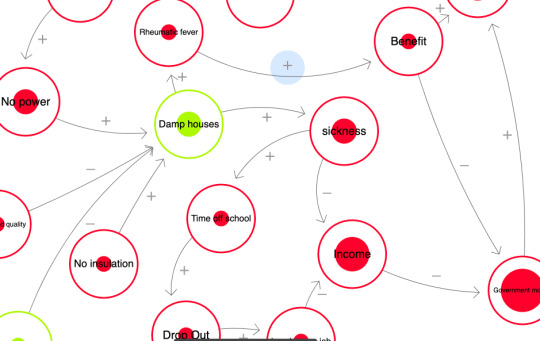
1. How could system thinking be used in your creative process:
This could be used for problem solving/creative solutions as it visually shows how a process can go. There is no limits to what can and can’t be added to the system which means that in creative thinking, there are multiple possible solutions to think of, problems that were not even thought about when making a system.
2. How could this method compliment or contrast with another method explored in ctec500:
Visually it works similar to ideation and the lotus method. Systems made like Loopy can show many factors, problems, solutions etc and then the lotus method works to take some of these points and create solutions from them. If someone is a very visual learner, these two methods would work really well together to create successful solutions.
0 notes
Text
WEEK 9
Wallet Design
My design for my partner had 2 clear card slips on both sides for cards that scan. It also zips up across the top and inside has lots of smaller card holding slips.


I asked my mum the questions for this blog post:
What did she like? - she liked the fact it had to clear spaces to scan a hop card or an access card since they are cards that are used quickly and can be a hassle to get out of your wallet in a short time.
What would she change? - she said that it might be easier to access cards if the zip went the whole way around meaning that it could flip open and cards would be found and out away easier.
Any questions? - why so many slips ? I explained that this was to cater for my partner in the exercise who said she would often just throw cards in her wallet not in their specific card slips so this design makes it less messy when a card is thrown in, and she can just throw another in but in a new slip avoiding mess.
Any ideas? - “nope”
Here are the changes I made based on her answers
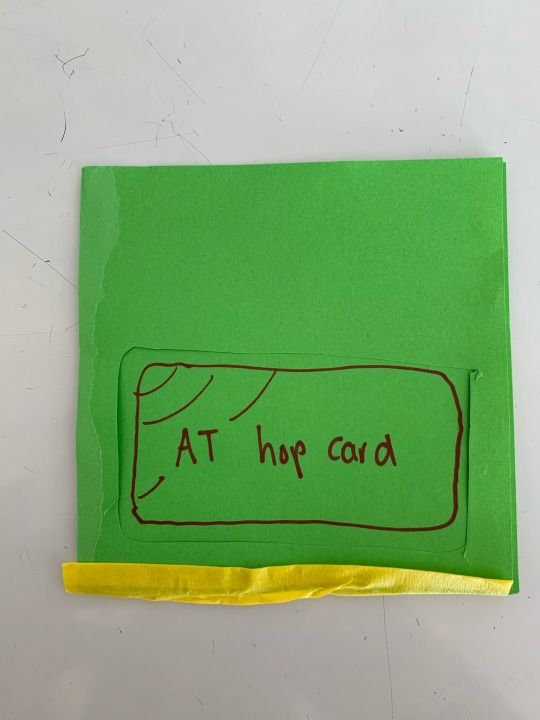

0 notes
Text
Week 7
Sectional Drawing
I found this exercise really interesting, I especially liked how we had to make our sectional drawings habitable, I had never really heard of this type of drawing before and it was fun to do. I am not the best drawer so I wasn’t too sure how this would go but I like the end result.

My object I cut in half was a small apple that had fallen off an apple tree in my garden.
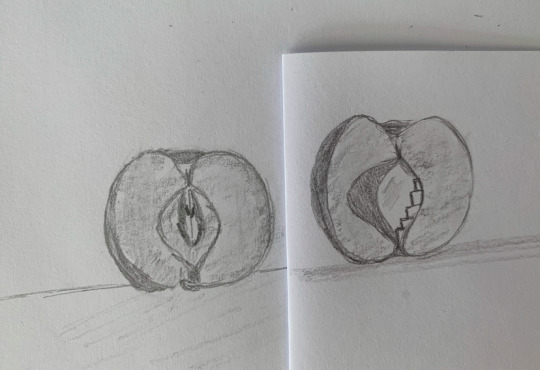

Since I am not a great drawer the only ways I really incorporate it into my work is with rough sketches, doodles, maps, etc. I had never really thought too much into these quick drawings but after this presentation I realised that it is vert important and a key part of any design process no matter the skill level. My quick drawings are a way to get an idea out fast and share it with my team mates so they can see what I am meaning and then we are able to develop it further as a group.
I think this would be a good method in work to design/plan/prototype many different uses, entrances, or anything really on product designs, buildings, etc. At first i struggled to think of a way to ‘inhabit’ the cross section but then once i did one, i got an idea for another and I think if there was more time I could have come up with a few more. Really interesting to see all the ways you can cut and move and develop a single design into something completely new and unique whilst also keeping its key characteristics.
0 notes
Text
Week 6
ideate
this week we tested out the lotus method of mind mapping which was a really great tool. I chose to focus my point around our studio project. In the time we had it was hard to get it all filled out but i’m happy with what I got down and have actually developed some new ideas from this.
1: I think this method is really useful for creative thinking as it enables you to break down your one idea into smaller parts and then continue to break those parts down even further. It helps turn the big idea in your mind into an organised layout of each point.
2: I will definitely be using this in future aspects of work and projects I do. Since this one was based on an ongoing project I will probably continue to work on this and see what more ideas I can get out of it. It is a very useful mind mapping tool.

I wasn’t entirely sure how the 6 thinking hat exercise worked but I filled it out as to how I understood the brief.
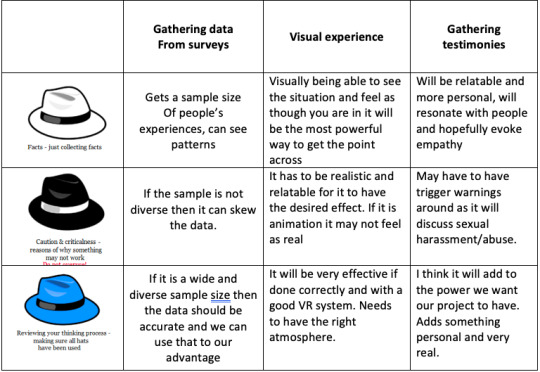

0 notes
Text
Week 5
LoFi Prototyping
In fort lane I chose the area around the entrance to the nightclub “ROXY”, however if this were to be implemented I think that the whole lane should be included.
My favourite thing about fort lane is the red neon light that runs from one end to the other zig zagging from wall to wall, moving around pipes and windows, it adds to the atmosphere whilst also looking very flush with its surroundings.
1: I took inspiration from this neon light and thought that adding some more, in different colours along the walls of the lane could continue to add to the existent atmosphere. Neon lights in different sized circles placed along the walls of the lane.
I didn’t have many materials at home however i did find a piece of cardboard that represented a part of the lane I could showcase the idea on.
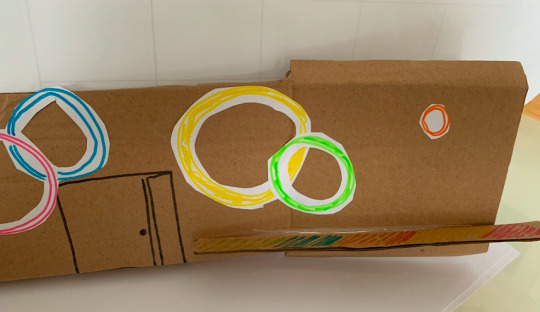
I then created a very basic edit of what it could look like if implemented, obviously at night this would have a much bigger impact as the lights can then stand out.
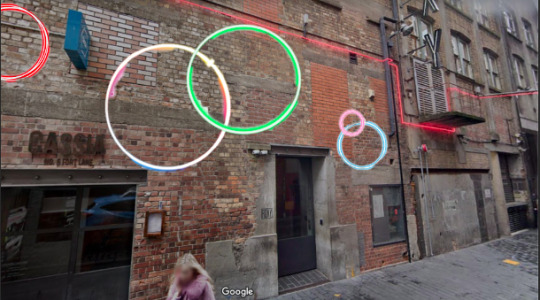
2: LoFi prototyping is a very good way of seeing a form of your idea in a physical form instead of your mind. In your mind there are no laws of physics and sometimes you don’t think things through properly. Until you see how it works in reality then you can see what works what doesn’t and what can be added to make it a better design.
0 notes
Text



this was our groups cultural probe. Our goal was to find a way to make public transport a more pleasurable experience for disabled people. We developed this idea that represented their journey on whichever public transport they were taking. Users can stick either a ‘heart’ or a ‘broken heart’ sticker on each stage of the journey representing if they felt comfortable and happy or uncomfortable/unsafe etc. The stages we used were- bus stop- getting on bus- actual journey sitting down-getting off
0 notes
Text
week one:
using walking as a research method:
homework questions:
in what ways did this exercise assist in seeing things you may have not noticed before?
I found that when we stopped walking to find and draw patterns around us, I saw details, shapes and textures in many places that I walk by all the time but have never noticed. After the first couple stops and drawings, I began noticing patterns all around us as we were walking to wherever we would stop next.
how might you adapt this method for future work?
I like the idea of walking aimlessly to spark up cognitive thinking, I think this could be used in most future work especially when it comes to mental blocks and times when we are lacking inspiration, walking could bring in some new ideas and refresh our minds.
0 notes
Text
week 2
Cultural Probes:
Now you have tested Cultural Probes, suggest another scenario where they could be used (be specific, who and where)
- cultural probes work well in the way that they get research information from people and their real life, day to day experiences. They could very helpful in understanding the lives of elderly with different communities and what could be implemented to make day to day experiences easier such as taking public transport or grocery shopping. Setting up a cultural probe in an area where this demographic is often around such as local markets, rest homes etc would get the best results.
What might be some failings of this method, how might the probes fail to work?
Since the research is taken from many hours or days of the participants lives, it is hard to monitor so problems might not be picked up and included within the final data.
0 notes
Link
Integrative Practise:
Team 8′s Blog | Pinwheel - Looking at Childhood including individual reflections
0 notes
Text
Colab Manifesto | Integrative Practise:
COLAB intend to deliver liberated thoughts and creative solutions that involve trans-disciplinary enquiry and practice. By applying tacit and explicit knowledge, students are taught to think deeper than the tip of the iceberg, and explore their imagination to create an inventive idea.
Innovation is the key to a creative theory and at COLAB, students are developed into young unorthodox and experimental thinkers. Minimalism is used in any and all projects, though the thought process that develops over an idea is not limited.
Students are encouraged to pursue the vision of a utopia. To create this vision, students collaborate, combining unique viewpoints.
Concerning Collaborative efforts, democracy and Socialism
Collaborative darwinism will be in effect: the strong shall go on, the weak shall be culled from the project. Adapt or die.
To create perfection is a worthless goal, for in doing so we shall damn ourselves and future generations to have nothing to strive towards. Instead, the goal should be to forever fall short: progress is for progress's sake.
Minimalism shall be used in any and all projects.
Everyone is special, but some people are more special than others. One must strive to break away from any and all guidelines and rules. This is to be followed without question.
Nothing shall be held to have any worth unless it is blogged in triplicate, has at least two “vines” made of it, is retweeted by at least five people, and is reflected on in a five thousand word treatise.
Man buns will not be tolerated, nor any hipster loving, vegan chugging behaviour. Hipster statements are to be made only in full irony. Self righteousness is discouraged.
We will aim to be inspirational, unique and to bring a higher level of thinking and being. We will operate from both the left and right side of our brain… and join together to create a unity in which we will be unstoppable human beings and greater than than sum of engineers and comp sci geeks in the other faculties.
Honour those before us, embrace our crazy, and create a brand new future.
Reflection:
This manifesto is aimed to represent the deep thinking behind COLAB as well as taking the light hearted humour out of our course. We wanted it to be funny and somewhat foolish, though still representing COLAB professionally. I have found that describing COLAB to people has been quite a challenge up until now. Many people who are not emerged in this type of environment do not understand what it means by using trans-disciplinary practice.
Our team, Amanda, Finley and myself, were able to rapidly type up this manifesto using the google docs function on google. We were able to jot down ideas throughout the week without being together which made the completion of this task efficient. This also allowed us to edit each others writing easily and combine sections to create a finished and polished COLAB manifesto.
0 notes
Text
Integrative Practise | Chat with Clinton | August 17:
The chat our table had with Clinton in todays lesson was very eye opening. He made me think about some ideas that I hadn’t thought about before which changed my perspective on the interrogations task, project 2.
We went around the table, one by one explaining how we went about this task and how we managed to track down James and our choice on sending our package. I noticed that everyone on the table started with Facebook, including myself. It seemed to be the most obvious way to find out who he was, where he was exactly, and also anything that he had done recently and shared with the world. I used this method first without really thinking of any other way to do it, but Clinton made me realise; what if I had? What if I had sent a letter without knowing where he was. I could have sent a package to somewhere completely different in Germany. I could have put a letter in a bottle and let it float somewhere in the ocean, hopping it will land in Germany? These ideas leave me in the unknown, though if it were to be successful, I think the process would be more satisfying.
The reality behind sending an actual package around the world leaves a connection with the sender and receiver and there is something satisfying about sending a package into the post, and making it travel in a meandering journey, compared to a simple email or message on Facebook. The feeling of receiving a package has more emotion connected to it as well, and I am more likely to remember the package, especially if the package is slightly roughed up. It makes me think, ‘where did this letter go? what happened to it?’ This also makes me think about social media and what it is doing to us, mentally. Humans have lost this emotional connection with messages because it is just ‘easier’ to send a tweet or Facebook message. Are these social media sites really doing their job? In a way yes, but also no. We are connected with others, even people on the other side of the world, but words in a digital message mean nothing compared to receiving a physical package in the post.
After having this chat with Clinton, I am super glad I did not settle for just a Facebook message. I sent my package to Berlin, and have put my trust in strangers in order for the package to successfully reach James. Could this be a test on how people react to the unknown? is it a test on society? are people willing to help people who they have never met and and never likely too considering thousands of miles are separating them? I guess I will find out in the next couple of weeks.
0 notes